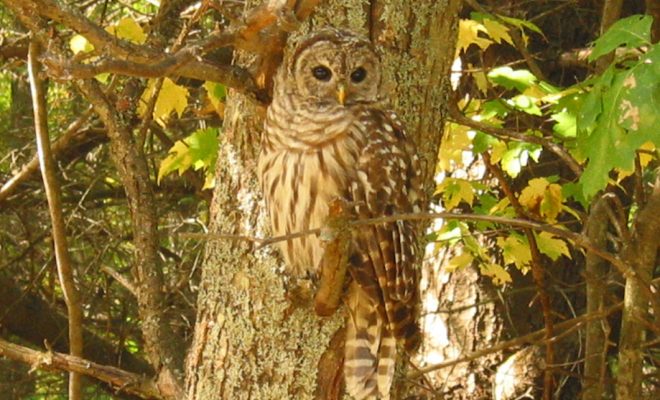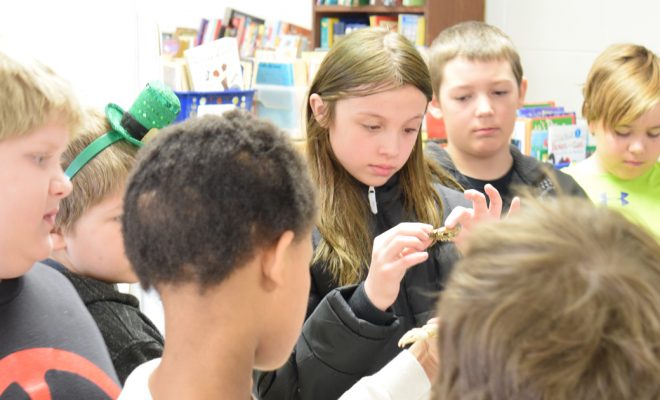Critter of the Month: Bumble Bees


Confusing bumblebee on Grass-Leaved goldenrod

Tri-colored bumble bee on Wild Bergamot

A yellow-banded bumble bee on Joe-Pye Weed. This bumble bee is listed as “of special concern” for potential endangerment of the species.
Photos by Nicole Shutt (USDA Forest Service)
Bumble bees are best known for their large fuzzy bodies and the loud buzzing sound they make as they fly. It is their size and buzz, however, which makes them excellent pollinators, especially for certain types of plants. Some plants, like tomatoes, peppers and cranberries, have very sticky pollen so not just any pollinator can transfer that pollen. Bumble bees actually shake the pollen loose from the flower by using their wings and flight muscles, creating the loud buzz in the process. This process is known as sonicating or buzz pollination. Because of this ability, domesticated bumble bees are often used in tomato greenhouses to provide pollination services.
What do bumble bees look like?
Bumble bees can range in size from three-quarters of an inch to 1 ½ inches long, depending on the species. Their bodies are covered with soft hairs, giving them that fuzzy look. Their bodies are also covered in oil that makes them waterproof. Most, but not all, species have broad bands of black and yellow. Bumble bees do not have ears, but they are sensitive to vibrations.
Though their short stubby wings make them appear as though they really shouldn’t be able to fly, bumble bees can actually travel quite fast, flying at an average speed of over three yards per second, which means they can fly the length of a football field in just 30 seconds. This is because their wings, which beat 200 times per second, do not move up and down but rather back and forth, like the partial spin of a helicopter rotor. The use of their wings and flight muscles also generates heat, which allows the bees to fly and forage during cooler weather.
Bumble bees may look large and ominous, but they are considered quite docile. Only the females have stingers, and they do not sting unless provoked.
Where do these bees live?
There are 225 species of bumble bees worldwide, with 49 of those found in North America. Of those in North America, 20 species can be found in Wisconsin. Bumble bees are considered social bees because they live in colonies. They build their colonies in the ground, preferring abandoned rodent burrows, but hey will also use piles of leaves, wood or compost.
Each colony contains 50-500 bees. There is one queen (reproductive female) bee, many worker bees (which are non-reproductive females), and a large number of eggs and larvae of developing bees. The queen’s main role is laying and hatching eggs, while the workers take care of the colony and forage for food.
What do bumble bees eat?
Bumble bees eat both pollen and nectar. They stick close to the colony, only traveling a five or six-mile radius for foraging. Bumble bees have hairy tongues to capture the nectar, allowing them to reach nectar in tubular and less open flowers. Each species have different length of tongues, which means each have specific types of flowers that they visit for nectar. They make a small amount of honey, which is produced for the purpose of feeding the colony. Bumble bees do not store a large amount of food at a time (only a few days worth) so constant foraging is necessary. This makes these bees exceptionally susceptible to food shortages.
What is their life cycle?
Only queen bumble bees live year round. The queens mate in the fall and then hibernate over the winter. In the spring, the queen will lay her first batch of eggs. She takes care of the eggs and keeps them warm for about two weeks. Once hatched, the queen will care for and feed the larvae for another two weeks, at which time the larvae spin cocoons around themselves and stay there until maturity.
The first bees to grow to adulthood are female (non-reproductive) worker bees, which take care of the colony and developing larvae. The queen continues to lay and hatch eggs throughout the summer, most of which will be female worker bees. The queen can lay fertilized eggs, which are females, or unfertilized eggs, which are males. The queen lays male and female eggs depending upon the needs to the colony and the time of the year.
At the end of the summer, drones, which are males, and future queens, which are reproductive females, are hatched. Once these bees reach adulthood, they leave the colony. Males will mate with future queens from other nests. The queens then put on weight and prepare for hibernation. The male drones and female workers die off in late fall.
What threats do bumble bees face?
Of the 20 species of bumble bees found in Wisconsin, one species is already endangered (rusty-patched bumble bee), and seven more are listed as “of special concern.” Bumble bee species that were once common to the northern United States and southern Canada are now rarely seen.
The main reasons for the decline are due to loss of environment, pesticide use, and disease. All these reasons contribute to the bees’ decline; there is not any one factor.
As suburban lawns take over once natural areas, and farm fields grow in size, environments for native pollinators are reduced or destroyed. Lawns and farm fields provide no plant diversity and very little flowering options for bees
Pesticides can cause immediate death to bumble bees, but even those exposed to lower levels of the toxin can transfer the chemical back to the colonies, causing bumble bee colonies to grow more slowly and produce fewer queens.
Disease can easily transfer from one bee to another. Domesticated bees which become infected can sometimes spread disease from one place to another due to the fact that domesticated bumble bees are often moved to service greenhouse plants in other locations. Domesticated bees come in contact with wild bees and transmit disease.
What can be done to help the bumble bee?
Like all pollinators, help can come in many forms: reducing lawn areas, planting native flowering plants in gardens or in farm field buffer strips, and limiting or completely eliminating the use of pesticides. There are also citizen science groups, like the Bumble Bee Brigade or Bumble Bee Watch, working to track sightings of bees to help scientists learn more about different species of bumble bees and where they are found. Learning more about bumble bee conservation, ways to create habitat, and how to help scientists can make a big contribution in helping these amazing pollinators.
Leave a reply
You must be logged in to post a comment.


